- Games, topic printables & more
- The 4 main speech types
- Example speeches
- Commemorative
- Declamation
- Demonstration
- Informative
- Introduction
- Student Council
- Speech topics
- Poems to read aloud
- How to write a speech
- Using props/visual aids
- Acute anxiety help
- Breathing exercises
- Letting go - free e-course
- Using self-hypnosis
- Delivery overview
- 4 modes of delivery
- How to make cue cards
- How to read a speech
- 9 vocal aspects
- Vocal variety
- Diction/articulation
- Pronunciation
- Speaking rate
- How to use pauses
- Eye contact
- Body language
- Voice image
- Voice health
- Public speaking activities and games
- Blogging Aloud
- About me/contact

How to write a speech introduction
12 of the best attention getters to start a speech
By: Susan Dugdale | Last modified: 01-12-2023
The audience settles in their seats. The lights dim. You walk out to the center of the stage. You pause, take a deep breath, open your mouth and begin.
What you say over the next 30 seconds to introduce your speech or presentation is crucial.
That's how much time you have to make a positive impression on your audience. In it they will decide whether or not you have anything relevant or useful to say. Those first impressions count!
So how do you write an effective speech introduction to grab and hold their attention?
Begin by finding out how to choose the right opener.
What's on this page:
- how to choose the right opener for your speech
12 of the very best ways to start a speech
3. What if?
5. Key fact
7. Rhetorical
9. Headlines
10. History
11. Challenge
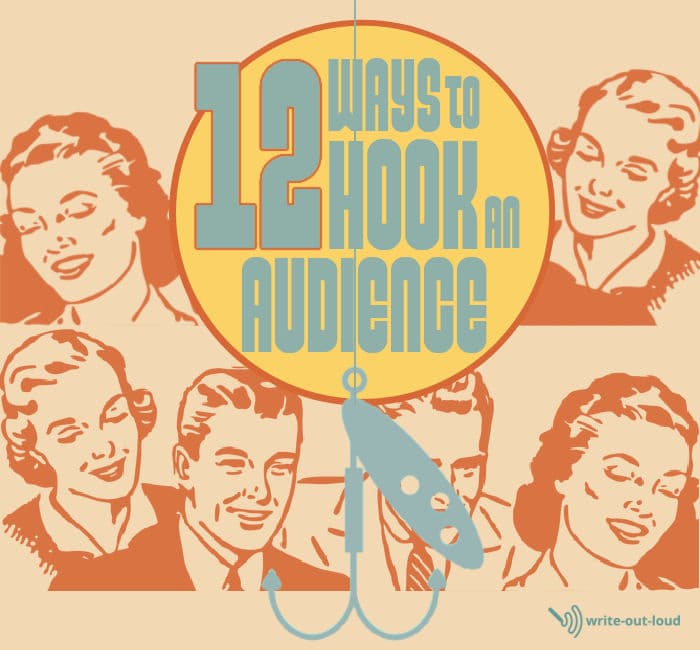
How to choose the right opener for your speech
The better way to make your choice of opener is after you have carefully considered who you are talking to and why you're talking to them.
One size does not fit all. Different audiences will respond differently. If you are giving the same speech multiple times think about what you may need to change to fit.
To work well your opening needs to be aligned with:
- the type of speech you're giving
- your main purpose for giving it
- your target audience and,
- their interests or needs
Both the hook * to catch their attention and your topic must be relevant to them. Unless they're a captive audience, they've come freely to listen to you and they're expecting something of value from you.
How are you going to let them know they're in the right place? Why should they listen? What are they going to get or gain through listening?
Out of all the different ways to open, what attention getter is absolutely the best way?
The only way I know to work out what is best is to go through each of them, and as you do, consider your audience. Make a short list of those you think might work then try them out before making your final choice.
* hook – an opening statement that immediately captures the audience's attention just like a well baited hook on a fishing line catches a fish.
Return to Top
1. Use imagination to create mind pictures
Ask the audience to use their imagination. Get them to build evocative compelling images in their minds. Make them large. Add vibrant color, sound and movement.
For example:
“Let's take a break. Make yourself comfortable. Now close your eyes for a moment. Take a deep breath, and you're there, in the place where you feel the most at ease, the place where all the tensions, all the demands of your normal everyday life disappear. Look around you. See it. Feel it. It's so good, it's perfect."
“Close your eyes. Take a deep breath and a moment to picture in your mind the people dearest to you, the people you feel you could not live without. Now when did you talk to them, or spend real time with them last?"
2. Use an item to build a connection
Choose an image or an object related to your speech, for instance a pair of shoes, to trigger interest and build a connection.
For example, if I were giving a speech on the lives of upper-middle class 19th century women I could open by holding up a pair of ornately decorated kid leather pumps.
“What's the name of the young woman who wore these? Listen. Can you hear the rustle of her silk skirts? And hear her heart beat bom-biddy-bom as the beau of the ball stepped her way? Would he, or wouldn't he ask her to dance?”
3. Ask a 'What if...?' rhetorical question
'What if...?' invites an audience to consider the possibilities of something becoming real. They can be positive somethings or negative, trivial or something that would have a significant impact if it came to pass.
The power of a 'what if...?' rhetorical question as an opener lies in the potency of the images and feelings it triggers. A well-chosen 'what if...?' will immediately have an audience wanting to hear the rest of your speech.
- "What if we don't find a way to successfully manage climate change?"
- "What if we really did solve the affordable housing crisis?"
- "What if questions of race and color ceased to matter?"
- "What if medicines were freely available to everybody who needed them?"
- "What if the person sitting next to you turned, looked into your eyes and said they loved you? Truly. Madly. Deeply."
4. Try a quotation from someone who's impacted your life in some way
To be effective a quotation doesn't have to be the clever quip or snippet of enduring wisdom: a famous quote from a well known person. It's origin could be personal, something someone important in your life said that's remained with you.
For example, my Mother answered all initial wails of outrage, pain or hurt from any of her five children with a command. "Breathe!" That was repeated, interwoven with encouraging asides, until whoever it was, was able to talk clearly and be understood. "It's OK.", she'd say. "Breathe. Come on. You can do it. Breathe. That's it. Keep going. Good."
Or I could use this line from one of my high school reports which read, "...with further maturity she should do well." (Thank you Mr Phillips. Your prediction was right on target.)
Or this from our son aged four as he watched me getting ready for another day of teaching: "When I grow up I'm going to wear pretty dresses and go to school just like you."
5. Use an interesting key fact
Choose an interesting key fact as an attention getting device: one of the most rarely known, or a shocking statistic from the body of your speech to open with.
For example: "Take a guess at what the most powerful and frequently used word is in the English language?
It's not one of those usually thought of candidates. Love? No. Money? Nope. Neither is it any member of your family... Mum, Dad, brother, sister, son, or daughter.
It's a three letter word, so common it's overlooked and taken for granted. 'The'. It's the humble 'the'."
(For more see this BBC article: Is this the most powerful word in the English language?
Or: "Between 2020/21 and 2021/2022, Americans consumed about 11 million metric tons of sugar, up from about 10 million metric tons in 2009/2010. Can you even begin to imagine the size of that sweet white mountain?"
(For more see: US sugar consumption statistics )
6. Share personal stories
Share a personal story related to your specific topic as the beginning of a speech. Done well, it lets the audience know you understand their situation and helps establish your credibility: your right to talk on the subject.
As an example here's the opening of a speech I gave about the impact of suicide on families and friends:
“One fine Spring day I biked home from school and found a policemen guarding our backdoor. Through it came sounds I'll never forget: my quiet Mother screaming. He said, "You can't go in."
I kicked him in the shins and did. It was the 15th of September, three days before my thirteenth birthday and my father was dead. Killed by his own hand. Suicide.”
(If you want to find out more about the speech and read it, it's here: After they're gone . It's an example persuasive speech using the five steps of Monroe's Motivated Sequence.)
7. Rhetorical questions
These are questions that although they are asked, they're never really intended to be answered by anyone other than the person asking them. * Their principal function is to act as a segue, or lead in, to what the person intends to say next. For instance, the first main point of your introduction.
Examples: "What if I were to say to you that there was no such thing as public speaking fear?"
"What do you think the main benefits of being able to speak up in public are?"
* Although there's bound to be someone in your audience who will. Be ready for them, and move on.
8. An empathetic question, aligning yourself with the audience and eliciting a response
These questions bring speaker and audience together, establishing a common ground, a mutual understanding, which is an effective way to ease into a speech. If your question 'works' you'll see heads nodding in agreement.
- "Have you ever experienced the butterflies in your stomach turning into a herd of rampaging elephants, just before you step up to give your presentation?"
- "Have you ever wanted a good day to never end?"
- "How often have you 'lost' your car in the supermarket car park?"
- "How often have you ever wanted to shout, NO? You want me to prepare a new presentation by tomorrow? NO. You want me to stay late, again? NO."
9. It's in the news
Take headlines from what's trending in media you know the audience will be familiar with and see.
Using those that relate to your speech topic as the opening of your speech is a good way to grab the attention of the audience. It shows how relevant and up-to-the-minute the topic is.
For example: "'Death toll soars to 76 in Florida after Hurricane Ian demolished entire communities.' 'Noru became a super typhoon in 6 hours. Scientists say powerful storms are becoming harder to forecast.' 'Hurricane Orlene strengthens into Category 4 storm as it heads toward western Mexico.'
Three front page headlines from CNN just today. Climate change. Let's do what we can."
10. This day in history
If you're giving a speech to celebrate a special birthday or an anniversary, consider using several carefully selected events that occurred on the same day as a speech opening. They could be either funny or serious, depending on the specific purpose of your speech. They're a great way to place the person in a much wider context and often with exalted company.
For example: "What do the 1863 National Thanksgiving Day proclamation by President Abraham Lincoln, National Boyfriend Day, and Gwen Stefani have in common with Joe? Yes, the 3rd of October! It's a great date made better by being Joe's birthday. And we say Gwen is truly privileged to have the same one as him."
11. Issue a challenge
Let the audience know first thing, at the beginning of the speech, what action you expect they'll be able to take by the time your presentation is complete. Then when you come to the final points, repeat the call to action, or challenge, as part of your closing statement.
For example: "I've a challenge for you. That's to sign up for our public speaking course. Right now you may not see yourself doing that. Public speaking? Me? I'd rather have a root canal done, without painkillers. However, by the end of the presentation...well, let's see. There's a first time for everything!"
Use a startling statement, a fact, or a series of facts, to jolt the audience into paying attention.
"Covid. We've had 1.06 million of us die in the US, so far. Today there are nearly 60,00 new cases. More mothers, fathers, friends, colleagues, children – people. People ill. People who might die. So why have we stopped wearing masks?"
For more: Google: Covid stats US

Other speech writing resources
- how to end a speech effectively : explanations with examples showing how to close a speech with impact
- how to write a speech : a detailed guide with examples covering audience analysis, planning, writing oral language, transitions, how to use an outline...
speaking out loud
Subscribe for FREE weekly alerts about what's new For more see speaking out loud

Top 10 popular pages
- Welcome speech
- Demonstration speech topics
- Impromptu speech topic cards
- Thank you quotes
- Impromptu public speaking topics
- Farewell speeches
- Phrases for welcome speeches
- Student council speeches
- Free sample eulogies
From fear to fun in 28 ways
A complete one stop resource to scuttle fear in the best of all possible ways - with laughter.

Useful pages
- Search this site
- About me & Contact
- Free e-course
- Privacy policy
©Copyright 2006-24 www.write-out-loud.com
Designed and built by Clickstream Designs
#2: Patrick Henry – “Give Me Liberty or Give Me Death”
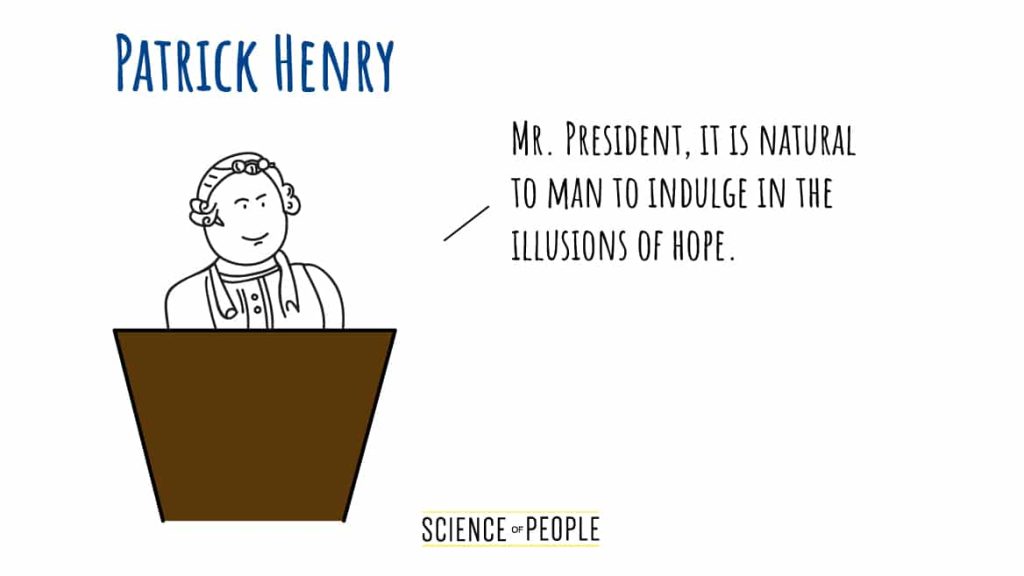
#3: Frederick Douglass – “The Hypocrisy of American Slavery”
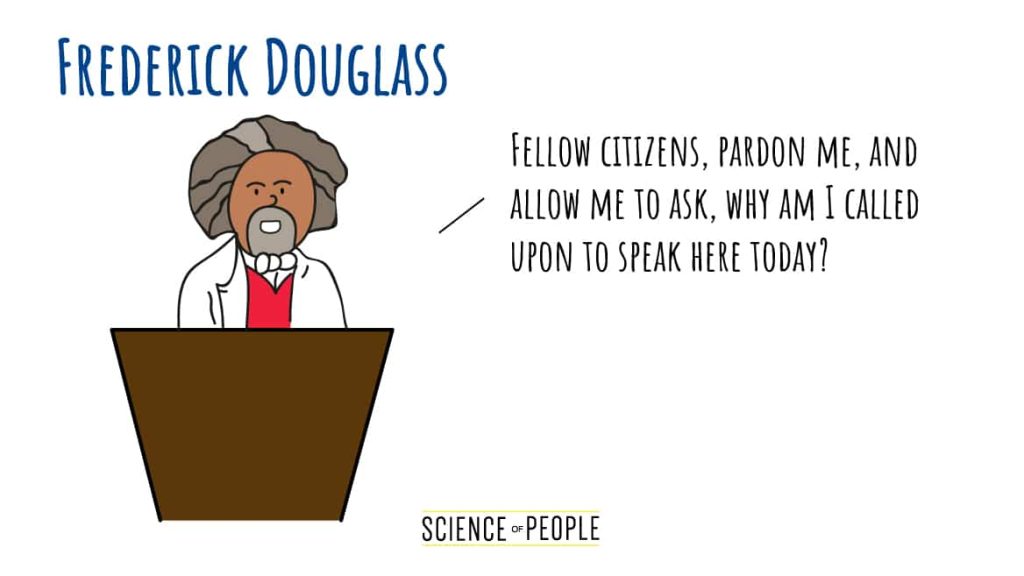
#4: Abraham Lincoln – “Gettysburg Address”
Opening Line: “Fourscore and seven years ago our fathers brought forth on this continent a new nation, conceived in liberty and dedicated to the proposition that all men are created equal.”
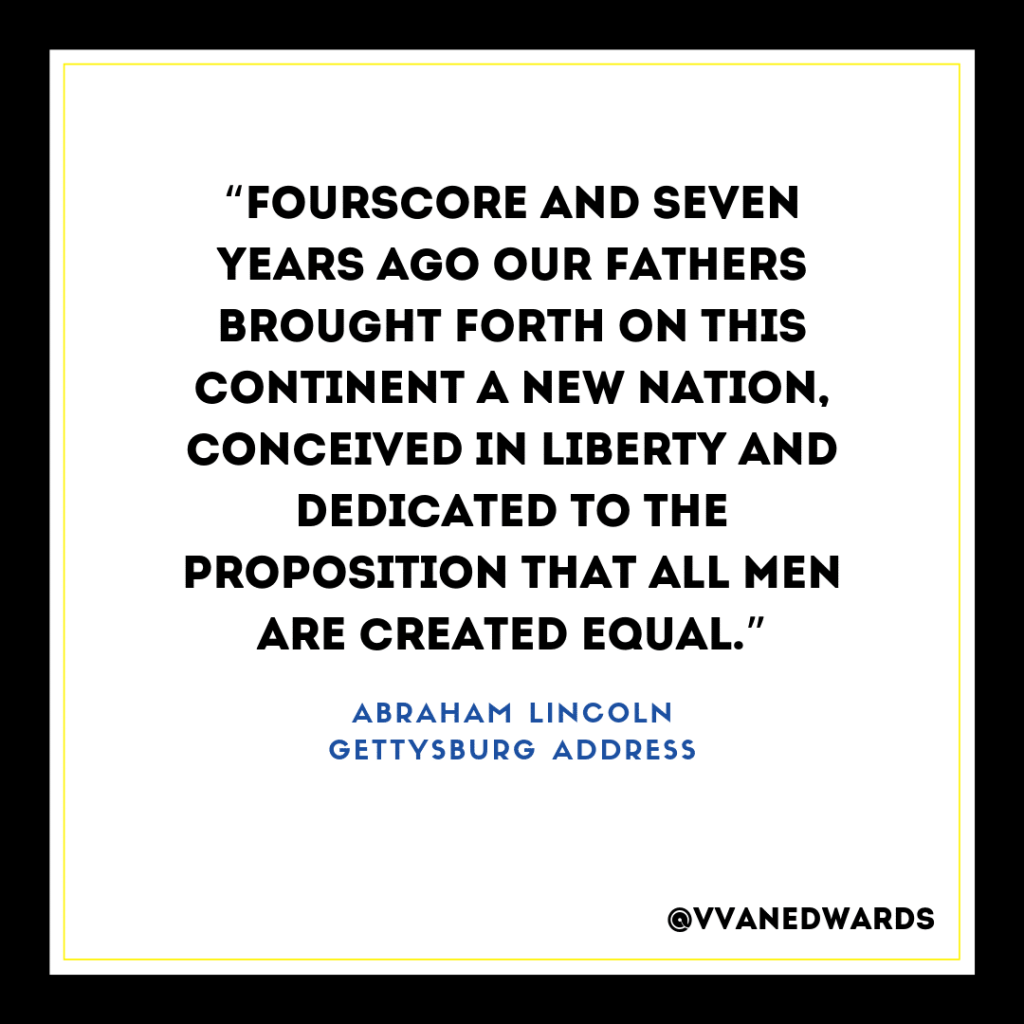
#5: Susan B. Anthony – “Women’s Rights to the Suffrage”
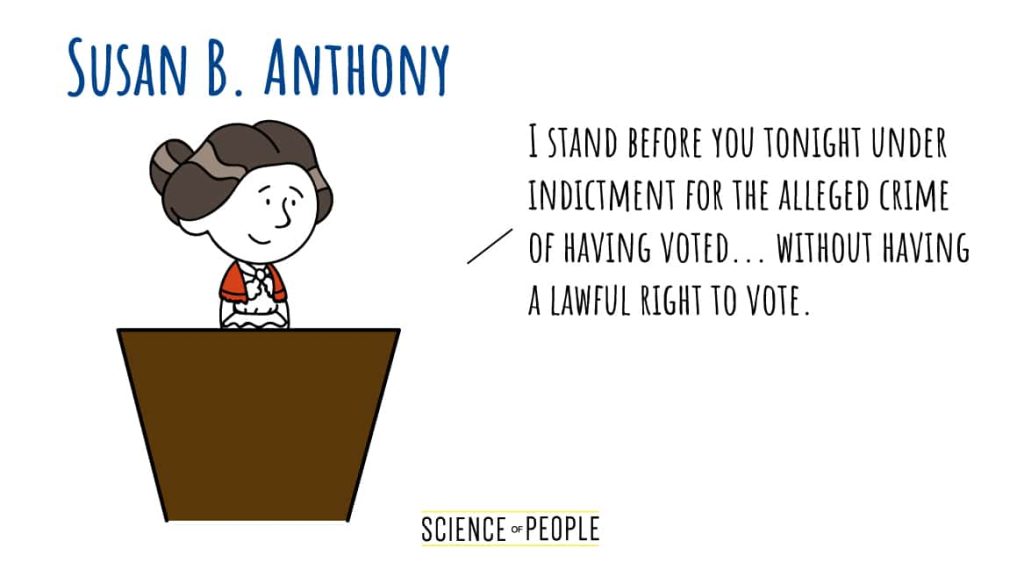
#6: Winston Churchill – “Blood, Toil, Tears, and Sweat”
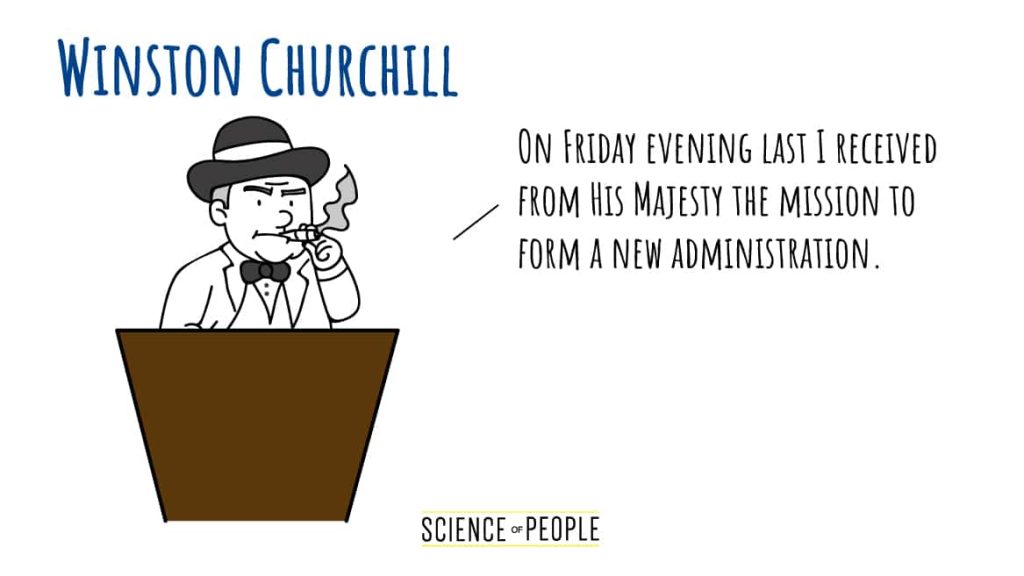
#7: John F. Kennedy – “Inaugural Address”
Opening Line: “We observe today not a victory of party, but a celebration of freedom — symbolizing an end, as well as a beginning — signifying renewal, as well as change.”
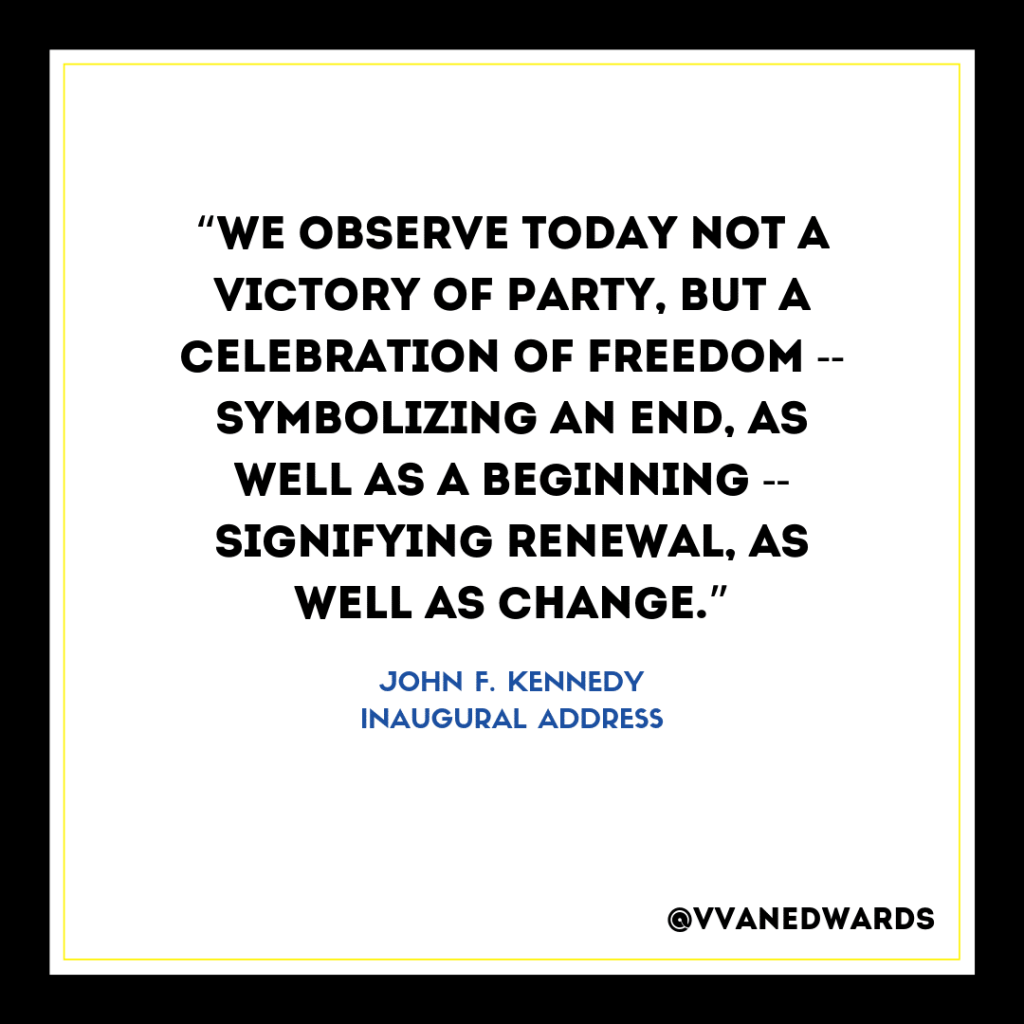
#8: Martin Luther King, Jr. – “I Have a Dream”
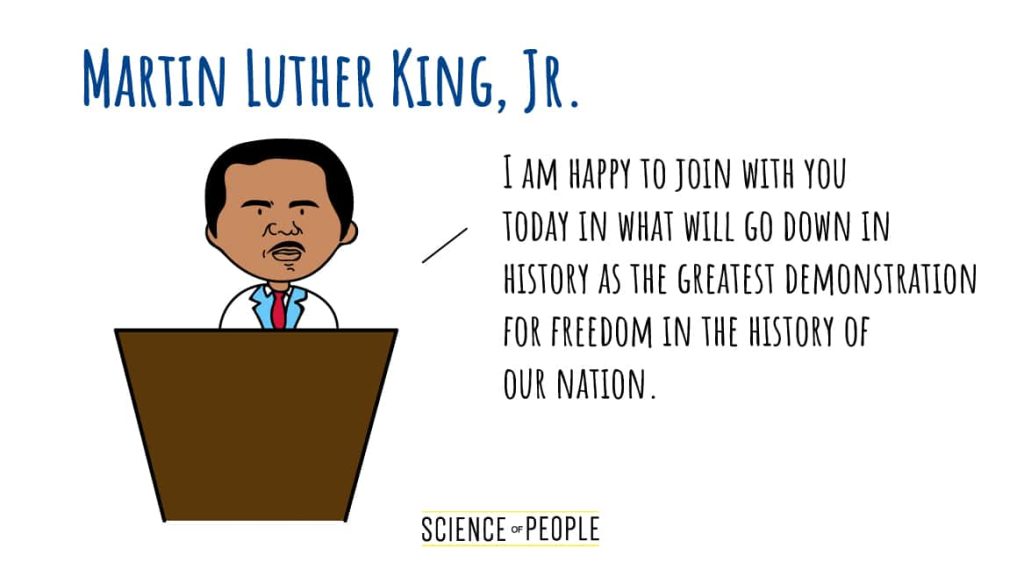
#9: Lyndon B. Johnson – “The American Promise”
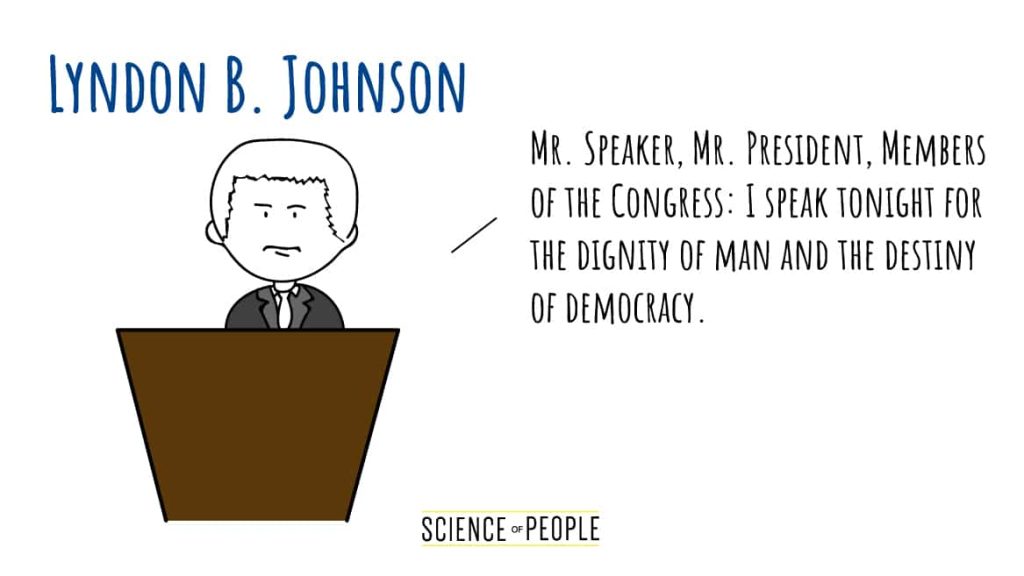
#10: Ronald Reagan – “Remarks at the Brandenburg Gate”
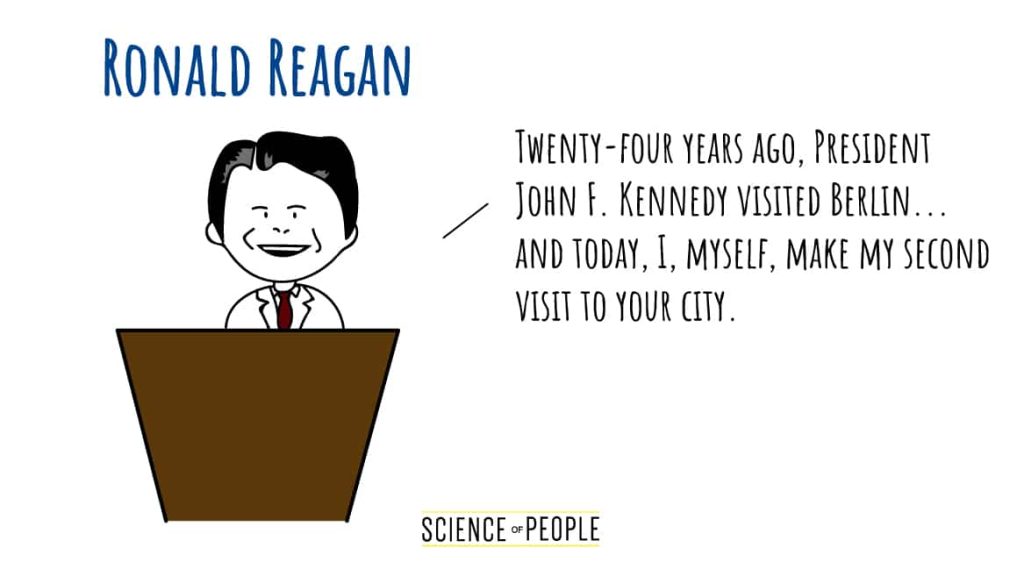
How do all of these historical greats start their speeches? Is there a difference between these and some of the more modern top TED talks?
Before we dive in, let’s recap with some critical do’s and don’ts when opening a speech:
Opening Lines of the Top 10 TED Talks of All Time
Here are the opening lines to the top 10 Ted Talks of all time according to view count:
#1: Sir Ken Robinson – “Do schools kill creativity?” Opening Line: “Good morning. How are you? It’s been great, hasn’t it? I’ve been blown away by the whole thing. In fact, I’m leaving.”
#2: Amy Cuddy – “Your Body Language May Shape Who You Are” Opening Line: “So I want to start by offering you a free, no-tech life hack, and all it requires of you is this: that you change your posture for two minutes.”
#3: Simon Sinek – “How Great Leaders Inspire Action”
#4: Brene Brown – “The Power of Vulnerability” Opening Line: “So, I’ll start with this: a couple years ago, an event planner called me because I was going to do a speaking event.”
#5: Mary Roach – “10 Things You Didn’t Know About Orgasm” Opening Line: “All right. I’m going to show you a couple of images from a very diverting paper in The Journal of Ultrasound in Medicine.”
#6: Julian Treasure – “How to Speak so that People Want to Listen” Opening Line: “The human voice: It’s the instrument we all play.”
#7: Jill Bolte Taylor – “My Stroke of Insight” Opening Line: “I grew up to study the brain because I have a brother who has been diagnosed with a brain disorder: schizophrenia.”
#8: James Veitch – “This is What Happens When You Reply to Spam Email” Opening Line: “A few years ago, I got one of those spam emails.”
#9: Cameron Russell – “Looks Aren’t Everything; Believe Me, I’m a Model” Opening Line: “Hi. My name is Cameron Russell, and for the last little while, I’ve been a model.”
#10: Dan Pink – “The Puzzle of Motivation” Opening Line: “I need to make a confession at the outset here.”
What can we learn from these opening lines? There are some patterns that can help us. First, let’s start with what you shouldn’t do. Have you ever made one of these cardinal speaking sins?
Never Start a Presentation with…
Anything technical! This is a big mistake people make when they have not done a tech check ahead of time or are feeling nervous. Never start with these openers:
- Is this microphone working?
- Can you hear me?
- Wow, these lights are bright!
Your nervousness. Many people think it is vulnerable to start with how nervous they are about speaking — you can mention this later, but it should not be the first thing. Why? People will then only be looking for signs of your nervousness. Don’t start with:
- I’m so nervous right now!
- Wow there are so many people here.
- I’m not a great public speaker.
A lackluster or non-believable nicety. It’s great to be grateful to the person who introduced you, but it’s not a great way to include the audience. It’s ok to thank the audience for being there—but do it at the end (not as your opening line). These are all too boring:
- Thanks for having me.
- Thanks for that intro.
- Nice to be here.
Boring, shmoring! I have an exception here if you can make it funny. Ken Robinson started with a nicety and then turned it into a joke. He said, “ “Good morning. How are you? It’s been great, hasn’t it? I’ve been blown away by the whole thing. In fact, I’m leaving.”
More Public Speaking Resources
Get even more public speaking tips with our related resources:
- 10 Presentation Ideas that will Radically Improve Your Presentation Skills
- 6 Public Speaking Apps to try Before Your Next Presentation
- My Top 5 Favorite Public Speakers
- 15 Science-Based Public Speaking Tips To Become a Master Speaker
- How to Give Captivating Presentations
- How to Give an Awesome Toast
How to Start a Presentation
A story. The absolute best way to start a presentation is with a story. There is nothing better to capture the imagination and attention of an audience. Try to use these speaking openers as fill-in-the-blanks for your speech.
- I’m here for a reason. And it’s an interesting story…
- The best thing that ever happened to me was…
- Once upon a time…
In his talk, “The lies our culture tells us about what matters,” David Brooks started off with a great opening line AND a story. He said, “So, we all have bad seasons in life. And I had one in 2013. My marriage had just ended, and I was humiliated by that failed commitment.” Makes you want to watch right…
And if you need help on storytelling basics, be sure to check out some of my top 5 favorite speakers .
A BIG idea. Sometimes you want to share your big idea right up front. This can be helpful because it is intriguing and gets people clued in right away. All TED speakers try to integrate their big idea early.
- You’re here for a reason. It’s…
- The single most important thing I want to share with you today is…
- Today, I want to share a big idea…
I love how Stacy Smith starts off her talk with her big idea framed in an interesting way. She said, “Today, I want to tell you about a pressing social issue. Now, it’s not nuclear arms, it’s not immigration, and it’s not malaria. I’m here to talk about movies.”
Special Note: Be very careful to NOT deliver your one-liner by re-reading your title slide. You also want to position it as exciting and intriguing. For example, don’t say, “Today I am going to talk about body language.” Instead say, “Today I am going to teach you the single most important thing you can do to improve your charisma… and it starts with your body.”
A quirky one-liner. If you can use humor — do it! Humor or curiosity is a great way to start a speech on a high. You can get creative with these! Think of an interesting fact about you, your audience or your topic that can lead you into your content.
- One thing most people don’t know about me is…
- A teacher, a mother and a duck walk into a bar…
- I want to tell you something surprising.
When I gave my TEDx London Talk I started off with a quirky one-liner that immediately got a few laughs. It was “Hi, I’m Vanessa and I am a recovering awkward person.” It worked so well it is also the first line of my book, Captivate .
II love the way Eve Ensler opens her speech with an interesting one-liner: “For a long time, there was me, and my body.”
This is a great tip from Conor Neill. He says that it is great to start with a question that the audience is asking themselves or would be very curious to know the answer to. This might be phrasing a pain point or worry for your audience.
- Do you ever worry about…?
- Have you ever wondered…?
- You might have always thought…
See Cono Neill’s examples here:
Did you know…? Any interesting factoid or curiosity is bound to intrigue your audience. This is great if it leads into your content or a story. I like to start with did you know… Here are some that I use. You will have to fill in the blank for your audience:
- Did you know that it takes less than a second to make a first impression ?
- Did you know that your nonverbal communication is 12.5 times more powerful than your words ?
- Did you know that we are lied to 200 times a day ?
Jamie Oliver does this amazingly in his TED Talk. He starts with this mind-blowing fact, “Sadly, in the next 18 minutes when I do our chat, four Americans that are alive will be dead through the food that they eat.”
Hopefully these opening lines will give you some ideas to use to open your speech.
How to End a Speech: My Favorite Closers
Do you know how to end on a high? Leave a lasting impression in your presentation? Science tells us that the first and last parts of your presentations are the most important. Get our FREE download to get our closer guide.
Popular Guides
How to deal with difficult people at work.
Do you have a difficult boss? Colleague? Client? Learn how to transform your difficult relationship. I’ll show you my science-based approach to building a strong, productive relationship with even the most difficult people.
Related Articles
Science of People offers over 1000+ articles on people skills and nonverbal behavior.
Get our latest insights and advice delivered to your inbox.
It’s a privilege to be in your inbox. We promise only to send the good stuff.

IMAGES
VIDEO